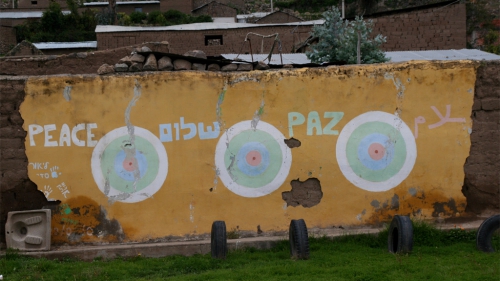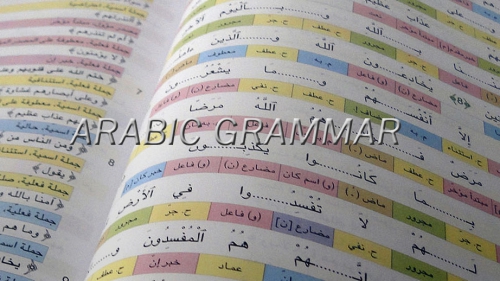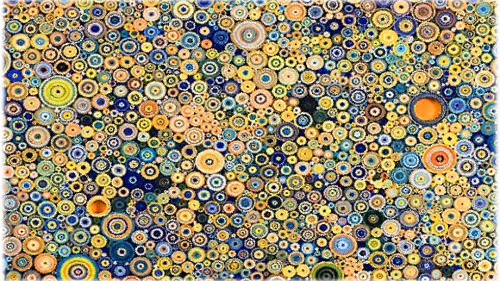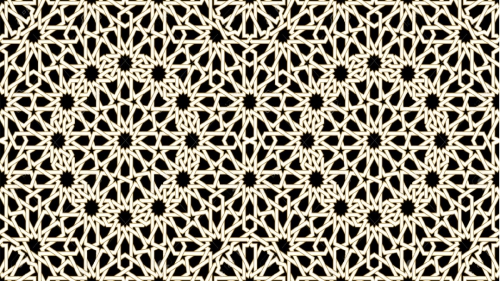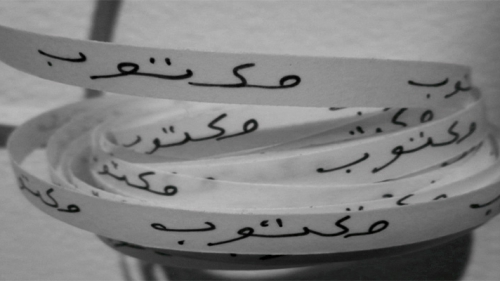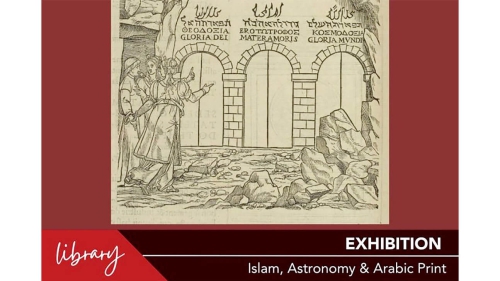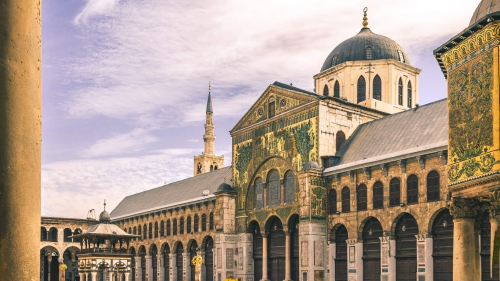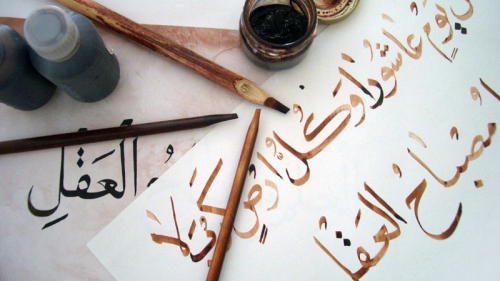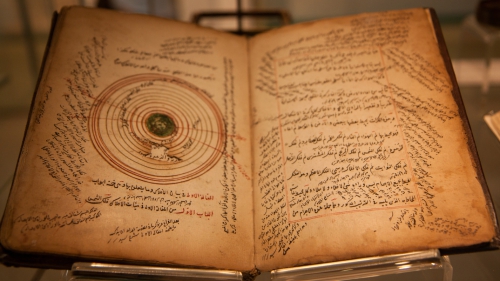Arabic literature

The Quran, the primary document of the Islamic faith, is the first Arabic book. Its style, at once vigorous, allusive, and concise, deeply influenced later compositions in Arabic, as it continues to color the mode of expression of native speakers of Arabic, Christian as well as Muslim, both in writing and in conversation.
The Quran also largely determined the course of Arabic literature. The earliest Arabic prose came into being not from literary motives, but to serve religious and practical needs, above all the need to fully understand the Islamic revelation and the circumstances of the first Muslim community in the Hijaz. The sayings and actions of the Prophet and his Companions were collected and preserved, at first by memory and then by writing, to be finally collected and arranged by such men as al-Bukhari and Muslim in the ninth century. This material, the hadith, not only provided the basic texts from which Islamic law was elaborated, but also formed the raw material for historians of the early Muslim community. Since each hadith, or "saying," is a first-person narrative, usually by an eyewitness of the event described, they have an immediacy and freshness that has come down unimpaired through the centuries. The personalities of the narrators - Abu Bakr, Umar, Aishah, and a host of others are just as vivid as the events described, for the style of each hadith is very personal.
The hadith also determined the characteristic form of such works as Ibn Ishaq's Life of the Messenger of God, originally written in the middle of the eighth century. In this book, hadith dealing with the life of the Prophet are arranged in chronological order, and the comments of the author are kept to a minimum. Events are seen through the eyes of the people who witnessed them; three or four versions of the same event are often given, and in each case the "chain of transmission" of the hadith is given, so that the reader may judge its authenticity.
During Umayyad times, a number of historians wrote monographs on specific historical, legal, and religious questions, and in each case these authors seem to have adhered to the hadith method of composition. Although few of the works of these writers have survived in their entirety, enough has been preserved by later incorporation in such vast works as the Annals of al-Tabari to give us an idea not only of their method of composition, but also of their wide-ranging interests.
The practice of prefacing a chain of authorities to each hadith led to the compilation of vast biographical dictionaries, like the Book of Classes of the early ninth century author Ibn Said, which includes a biography of the Prophet and a great deal of information on notable personalities in Mecca and Medina during his lifetime. Works such as this allowed readers to identify and judge the veracity of transmitters of hadith; later, the content of biographical dictionaries was broadened to include poets, writers, eminent reciters of the Quran, scientists, and the like. These biographical dictionaries are often lively reading, and are a mine of information about social and political circumstances in the Islamic world.
The spread of Islam naturally found chroniclers, such as al-Waqidi, who wrote in the late eighth and early ninth centuries, and al-Baladhuri, who composed his well known Book of the Conquests in the ninth century. These books, like the hadith, were written for practical motives. Al-Waqidi was interested in establishing the exact chronology of the spread of Islam in the Arabian Peninsula and adjoining areas, while al-Baladhuri was interested in legal and tax problems connected with the settlement of new lands. Their books nevertheless are classics of their kind and, aside from containing much interesting information, they have passages of great descriptive power.
By the ninth century, the method of compiling history from hadith and carefully citing the authorities for each tradition - a process which had resulted in books of unwieldy length - was abandoned by some authors, like al-Dinawari and al-Ya'qubi, who omitted the chains of transmitters and combined hadith to produce a narrative. The result was greater readability and smaller compass, at the sacrifice of richness and complexity. The works of al-Dinawari and al-Ya'qubi, unlike those of their predecessors, aimed to entertain as well as instruct; they are "literary" productions. This form of light history reached its apogee in the tenth century in al-Mas'udi's brilliant and entertaining Meadows of Gold and Mines of Gems, a comprehensive encyclopedia of history, geography, and literature. The literary productions of these men would not, however, have been possible without the careful collections of historical hadith made by their predecessors.
Just as the writing of history began from practical rather than literary motives, so the collection and preservation of Arabic poetry was undertaken by scholars with, at first, little interest in its artistic merit. The linguists and exegetes of Kufa and Basra began collecting this poetry in the eighth century because of the light it threw on unusual expressions and grammatical structures in the Quran and the hadith. Editions and commentaries were prepared of the poems of 'Antarah, Imru al-Qays, and many others, and thus the works of the early poets were preserved for later generations.
The Quran a part, poetry has always been considered the highest expression of literary art among the Arabs. Long before the coming of Islam, Bedouin poets had perfected the forms of panegyric, satire, and elegy. Their poetry obeys strict conventions, both in form and content, which indicates that it must have had a long period of development before it was finally committed to writing by scholars.
The principal form used by the desert poets was the qasidah or ode, a poem of variable length rhyming in the last syllable of each line. The qasidah begins with a description of the abandoned encampment of the poet's beloved and goes on to an account of his anguish at her absence and his consuming love for her. The poet then describes an arduous journey across the desert and ends the qasidah with an appeal to the generosity of his host. Although the subject matter is almost invariable, the language is very complex and of great precision.
In the Hijaz during the first century of Islam, contemporary with the first hadith scholars, a group of poets broke with the past and introduced new forms and subjects. Men like 'Umar ibn Abi Rabi'ah wrote realistic and urbane verse, and a school of poetry which expressed the themes of Platonic love grew up around the poet Jamil ibn Muiammar, better known as Jamil al-'Udhri. The lives and works of these poets of the Umayyad period are preserved in the entertaining tenth-century anthology by Abu al-Faraj al-Isfahani, the Book of Songs.
The Umayyad court in Damascus patronized poets and musicians. It was also the scene of the development of the type of Arabic literature called adab. Adab is usually translated as "belles-lettres," which is slightly misleading. This literature, at least in its inception, was created to serve the practical end of educating the growing class of government ministers in the Arabic language, manners and deportment, history, and statecraft. Works in Sanskrit, Pahlavi, Greek, and Syriac began to find their way into Arabic at this time. 'Abd al-Hamid ibn Yahya al-Katib, an Umayyad official, and the creator of this genre, defined its aims as follows: "Cultivate the Arabic language so that you may speak correctly; develop a handsome script which will add luster to your writings; learn the poetry of the Arabs by heart; familiarize yourself with unusual ideas and expressions; read the history of the Arabs and the Persians, and remember their great deeds." 'Abd Allah ibn al-Muqaffa', a contemporary of 'Abd al-Ham id ibn Yahya, translated the history of the ancient kings of Persia into Arabic, as well as Kalilah wa-Dimnah, an Indian book of advice for princes cast in the form of animal fables. His works are the earliest surviving examples of Arabic art prose and are still used as models in schools throughout the Middle East.
By the ninth century, Arabic literature had entered its classical age. The various genres had been defined - adab, history, Quranic exegesis, geography, biography, poetry, satire, and many more. Al-Jahiz was perhaps the greatest stylist of the age, and one of the most original personalities. He wrote more than two hundred books, on every conceivable subject; he was critical, rational, and always amusing. His Book of Animals is the earliest Arabic treatise on zoology and contains very modern-sounding discussions of such things as animal mimetism and biological adaptation. He wrote one of the earliest and best treatises on rhetoric and a large number of amusing essays. By the time of his death at the age of ninety-six he had shown that Arabic prose was capable of handling any subject with ease. The most gifted of al-Jahiz's contemporaries was probably Ibn Qutaybah, also a writer of encyclopedic learning and an excellent stylist. His Book of Knowledge, a history of the world beginning with the creation, is the earliest work of its kind and later had many imitators.
The tenth century witnessed the creation of a new form in Arabic literature, the maqamat. This was the title of a work by al-Hamadhani, called Badi' al-Zaman, "The Wonder of the Age." His Maqamat ("Sessions") is a series of episodes written in rhymed prose concerning the life of Abu al-Fath al-Iskandari, a sort of confidence trickster, who takes on a different personality in each story and always succeeds in bilking his victims. These stories are witty and packed with action, and were immediately popular. Al-Hamadhani was imitated by al-Hariri a hundred years later. Al-Hariri was a linguistic virtuoso, and his Maqamat is filled with obscure words, alliteration, puns, and wild metaphors. He too was extremely popular, and many learned commentaries were written on his Maqamat. This purely Arab form can most closely be compared with the Spanish picaresque novels, which it may have influenced.
Rhymed prose, which had come to be used even in government documents, was employed by Abu al-'Ala al-Ma'arri in his Message of Forgiveness, one of the best known of Arabic prose works. Al-Ma'arri lived in the eleventh century, leading an ascetic life in his native Syrian village. Blind from the age of four, he possessed a prodigious memory and great intellectual curiosity and skepticism. The Message of Forgiveness is cast in the form of a journey to paradise; the narrator there interrogates the scholars and poets of the past regarding their lives and works, receiving surprising and often ironic responses. The book is an extended critique of literature and philology, and represents a high point of classical Arabic culture.
One of the other great figures of late classical literature was the poet al-Mutanabbi, whose skill in handling the complex meters of Arabic poetry was probably unsurpassed. His verbal brilliance has always been admired by Arab critics, although it is difficult for those whose native tongue is not Arabic to appreciate it fully.
The period between the fall of Baghdad to the Mongols in 1258 and the nineteenth century is generally held to be a period of literary as well as political decline for the Arabs. It is true that during these five hundred years Arabic writers were more preoccupied with the preservation of their literary heritage than with the development of new forms and ideas. This is the age of encyclopedias, commentaries, and lexicons. Faced with the massive destruction of books by the invasions of Genghis Khan and Hulagu and later of Tamerlane, scholars compiled digests and abridgments of works that had survived in order to ensure their continued existence.
There were also some original works, however. Ibn Battutah, the greatest traveler of the Middle Ages, lived in the fourteenth century, and his Travel provide a fascinating picture of the Muslim world, from the islands of the Indian Ocean to Timbuktu. Ibn Khaldun, like Ibn Battutah a native of North Africa, lived in the later fourteenth and early fifteenth centuries. His Prolegomena is a work of brilliance and originality; the author analyzes human society in terms of general sociological laws and gives a lucid account of the factors that contribute to the rise and decline of civilizations. Ibn Khaldun's style is innovative, simple, and very personal, and perfectly suited to the expression of his often difficult ideas.
This post classical period also saw the composition of popular romances, such as the Romance of 'Antar, based on the life of the famous pre-Islamic poet; the Romance of the Bani Hilal, a cycle of stories and poems based on the migration of an Arabian tribe to North Africa in the eleventh century; and many more. These romances could be heard recited in coffee shops from Aleppoto Marrakesh until very recently. The most famous popular work of all, The Thousand and One Nights, assumed its present form during the fifteenth century.
A revival of Arabic literature began in the nineteenth century, and coincided with the first efforts of Arabic speaking nations to assert their independence of Ottoman rule. Napoleon, during his brief occupation of Egypt in the late eighteenth century, introduced a printing press with fonts of Arabic type, and Muhammad 'Ali, ruler of Egypt from 1805 to 1848, initiated a series of projects to modernize Egypt. He encouraged the use of Arabic in schools and government institutions, and established a printing press. Selected Egyptian students were sent to study in France, and on their return assigned to undertake translations of Western technical manuals on agriculture, engineering, mathematics, and military tactics. These works, together with many of the classics of Arabic literature, were printed at the government press at Bulaq and had a profound impact on intellectuals in the Arab East.
Another factor in the literary revival was the swift growth of journalism in Lebanon and Egypt. Starting in the late 1850s, newspapers were soon available through the Middle East. By 1900 well over a hundred and fifty newspapers and journals were being published. These journals had a great influence on the development and modernization of the written Arabic language; their stress on substance rather than style did much to simplify Arabic prose and bring it within the comprehension of everyone.
One of the first leaders of the Arabic literary renaissance was the Lebanese writer and scholar Butrus al-Bustani, whose dictionary and encyclopedia awakened great interest in the problems of expressing modern Western ideas in the Arabic language. His nephew Sulayman translated Homer's Iliad into Arabic, thus making one of the first expressions of Western literature accessible to the Arabic-reading public. Other writers, such as the Egyptian Mustafa al-Manfaluti, adapted French romantic novels to the tastes of the Arab public, as well as writing elegant essays on a variety of themes.
The historical novel, in the hands of Jurji Zaydan, proved immensely popular, perhaps because of the intense interest Arabs have always had in their past, and because of the novelty of a new form. But the first Arabic novel that can rank with European productions is Muhammad Husayn Haykal's Zaynab, set in Egypt and dealing with local problems.
Perhaps the greatest figure in modern Arabic literature is Taha Husayn. Blind from an early age, Taha Husayn wrote movingly of his life and beloved Egypt in his autobiography, al-Ayyam, "The Days." Taha Husayn was a graduate of both al-Azhar and the Sorbonne, and his voluminous writings on Arabic literature contributed a new critique of this vast subject.
The novel was not the only new form introduced to the Arabic-reading public. The drama, first in the form of translations of Western work, then of original compositions, was pioneered by Ahmad Shawqi and came to maturity in the hands of Tawfiq al-Hakim. Tawfiq al-Hakim's long career and devotion to the theater did much to make this one of the liveliest arts of the Middle East.
The history of modern Arabic poetry, with its many schools and contending styles, is almost impossible to summarize. Traditional forms and subjects were challenged by 'Abbas Mahmud al-'Aqqad, Mahmud Shukri, and Ibrahim al-Mazini, who strove to introduce nineteenth-century European themes and techniques into Arabic, not always with success. Lebanese poets were in the forefront of modernist verse, and one of them, Gibran Kahlil Gibran, proved very popular in the West. Poets are now experimenting with both old and new techniques, although discussions of form have given way to concern for content. The exodus of Palestinians from their native land has become a favorite theme, often movingly handled.
In Saudi Arabia, it was not until well into the twentieth century that literary movements in neighboring lands made themselves felt. Poetry, of course, has been cultivated in Arabia since the pre-Islamic period, and it has lately been influenced by new forms and subjects. Hasan al-Qurashi, Tahir Zamakhshari, Hasan Faqi, and Mahrum (the pen name of Amir 'Abd Allah al-Faysal) have won renown for their poetry throughout the Arab world. Hasan Faqi's poetry is introspective and philosophical, while the verse of the three others is lyrical and romantic. Ghazi al-Gosaibi is distinguished by a fresh, fecund imagination that expresses itself in both Arabic and English verse. Two novels by the late Hamid al-Damanhuri have been well received. They are Thaman al-Tadhiyah, "The Price of Sacrifice," and Wa-Marrat al-Ayyam, "And the Days Went By." With the rapid increase in education and communications, presses are now beginning to publish more and more works by writers, and it can certainly be expected that the great social changes that are taking place will eventually be reflected in equally far-reaching developments in the Arabic literature.






